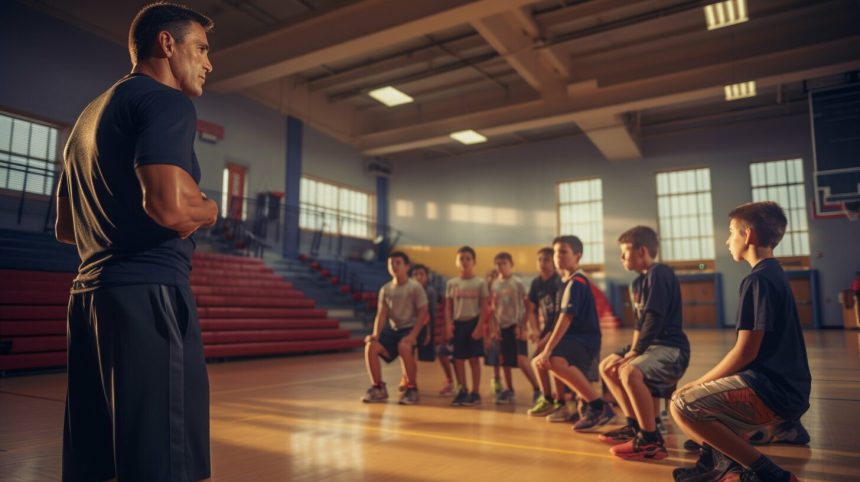Sports coaching is a demanding role that comes with certain health and safety risks. Coaches work closely with athletes, often engaging in physical activities and working in various environments, which can pose different hazards. As such, coaches need to be aware of the potential risks they face and take appropriate measures to prevent accidents and ensure athlete safety. In this section, we will explore the different types of health and safety risks that sports coaches face.
Key Takeaways:
- Sports coaches face physical injuries and accidents when engaging in physical activities alongside their athletes.
- Environmental hazards and weather conditions can pose a threat to coaches and athletes.
- Mental and emotional well-being can be impacted by the demands of coaching and performance pressures.
- Coaches need to be prepared to handle medical emergencies and provide first aid to athletes.
- Proper hygiene practices, immunizations, and communicable disease prevention are crucial for coaches and athletes.
Physical Injuries and Accidents
Sports coaches often engage in physical activities alongside their athletes, exposing themselves to the same risks. As such, physical injuries and accidents are one of the primary health and safety risks for coaches. These can include sprains, strains, fractures, and even concussions.
Preventing such accidents is critical to ensuring athlete safety. Coaches should properly warm up and stretch before engaging in physical activities, wear appropriate safety gear, and provide instruction on proper techniques and form. Additionally, coaches should be aware of the physical limitations of their athletes and adjust activities accordingly.
In the event of an injury or accident, coaches need to know how to respond appropriately. This includes providing immediate first aid, knowing when further medical attention is necessary, and having an emergency action plan in place. Coaches should also keep a well-stocked first aid kit on hand at all times.
Common Physical Injuries for Coaches
| Injury Type | Description |
|---|---|
| Sprains and Strains | Stretching or tearing of ligaments (sprains) or muscles or tendons (strains) due to overexertion, falls, or collisions. |
| Fractures | A break or crack in a bone, typically caused by a fall or impact. |
| Concussions | A type of traumatic brain injury caused by a blow to the head or body, resulting in a range of symptoms from headaches to loss of consciousness. |
By taking appropriate measures to prevent physical injuries and knowing how to respond in an emergency, coaches can ensure a safe and healthy environment for themselves and their athletes.
Environmental Hazards and Weather Conditions
Being a sports coach involves working in various environments, both indoor and outdoor. While most sports are played in comfortable and safe conditions, sometimes there can be harmful environmental hazards that coaches need to be aware of. It is important for coaches to take the necessary precautions to ensure both their own and their athletes’ safety and well-being.
Environmental Hazards
Coaches and athletes can be exposed to various environmental hazards, such as extreme temperatures, poor air quality, and natural disasters. Extreme temperatures can lead to heat exhaustion or hypothermia, which can be life-threatening if not treated immediately. Poor air quality caused by pollution, pollen, or dust can trigger asthma or other respiratory problems in athletes. Natural disasters, such as hurricanes, earthquakes, or tornadoes, can also put coaches and athletes in danger.
Therefore, coaches should take several preventive measures, such as monitoring weather forecasts, having a backup plan, and staying updated with emergency alerts. When it comes to extreme temperatures, coaches should schedule practices and games during the cooler parts of the day, ensure proper hydration, and provide shade or cooling stations. In case of poor air quality, coaches should move practices and games indoors, check air pollution levels regularly, and have asthma medication available. In the case of natural disasters, it is essential to have emergency protocols in place and ensure that everyone knows what to do in case of an emergency.
Weather Conditions
Aside from environmental hazards, weather conditions can pose a risk to coaches and athletes. Thunderstorms, lightning, heavy rain, or snow can lead to injuries or accidents on the field. In case of thunderstorms or lightning, coaches should follow the 30/30 rule, which means suspending all outdoor activities when thunder is heard within 30 seconds after a lighting strike, and waiting at least 30 minutes before resuming them. When it comes to heavy rain or snow, coaches should inspect the field for any holes or bumps that could cause injuries, delay practices, and keep athletes off slippery surfaces.
Overall, coaches should always prioritize the well-being and safety of their athletes, and be prepared for any unexpected hazards or weather conditions. By taking the necessary precautions and measures, coaches can ensure that both they and their athletes can enjoy sports to the fullest in a safe and healthy environment.
Mental and Emotional Well-being
Coaching is a highly demanding profession that requires tremendous physical and mental energy. Coaches often experience high levels of stress, which can take a toll on their mental and emotional health if not managed properly. It is important for coaches to prioritize their own well-being in order to effectively lead and support their athletes.
One of the biggest risks to coaches’ mental and emotional health is stress. Balancing the demands of coaching with personal responsibilities can lead to burnout if not managed properly. Coaches should prioritize self-care practices such as regular exercise, healthy eating habits, and engaging in hobbies or activities they enjoy.
It is also essential for coaches to recognize signs of burnout and seek support when needed. This may include consulting with a mental health professional or seeking guidance from a mentor or peer.
Additionally, coaches must manage the pressures of athlete performance expectations. While coaches are responsible for supporting their athletes’ development and success, they must also ensure they are not taking on too much responsibility for their athletes’ outcomes. Coaches should focus on creating a positive and encouraging environment that fosters growth and development.
Overall, maintaining a healthy work-life balance and practicing stress management techniques is crucial for coaches’ mental and emotional well-being. By prioritizing their own health and well-being, coaches can better support their athletes and create a positive coaching experience for all.
Communicable Diseases and First Aid
Coaches’ close interaction with their athletes puts them at risk of exposure to communicable diseases. It’s crucial for coaches to implement proper hygiene practices, such as washing hands regularly and using sanitizers, to prevent the spread of germs. Additionally, coaches must ensure their athletes are up-to-date with immunizations and educate them on the importance of good hygiene.
Being prepared for medical emergencies is also essential in safeguarding the health and safety of athletes. Therefore, coaches should have the necessary knowledge and training to provide immediate first aid to athletes in case of injuries or medical issues.
Every coach should have a well-stocked first aid kit with basic medical supplies, such as bandages, antiseptics, and pain relievers. They should also have an emergency action plan that outlines the steps that should be taken in case of a medical emergency. This plan should include the location of the nearest hospital, emergency contact information, and the roles and responsibilities of each person involved in the emergency response.
In conclusion, coaches should prioritize athlete safety by taking necessary measures to prevent the spread of communicable diseases and be prepared for medical emergencies. The combination of good hygiene practices, immunizations, proper first aid training, and emergency action plan will go a long way in ensuring the well-being of coaches and their athletes.










